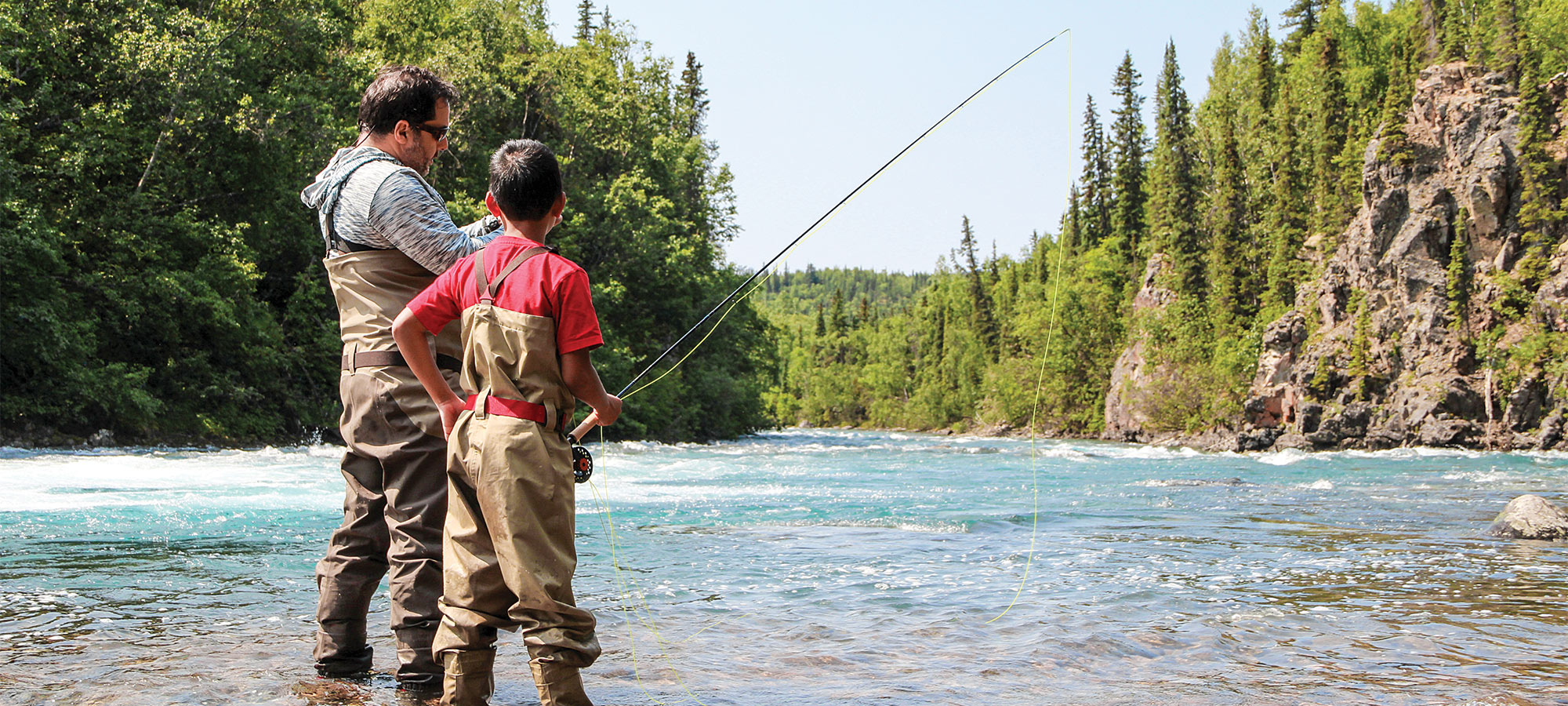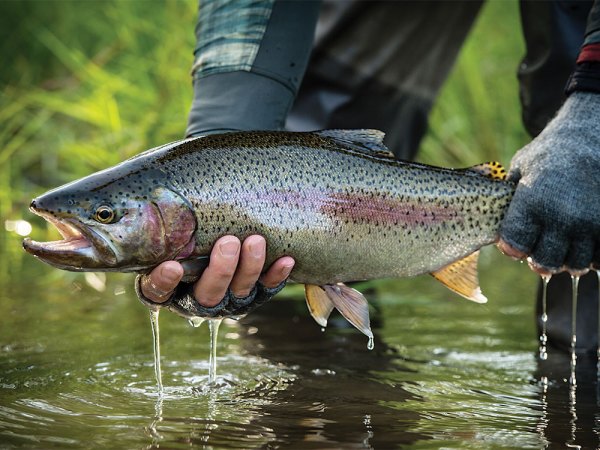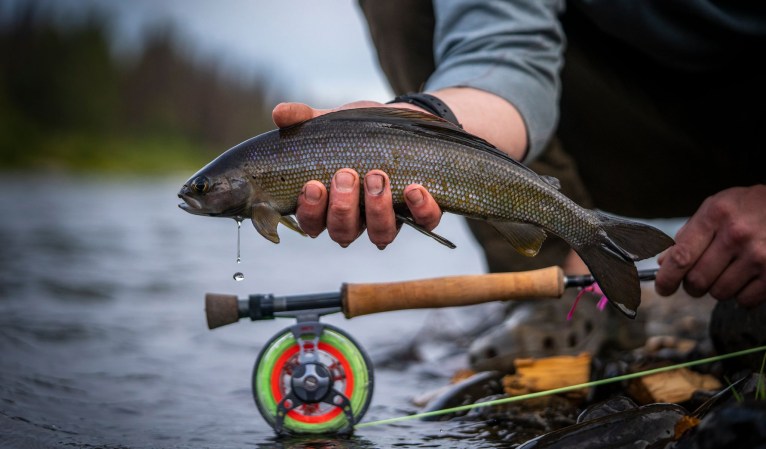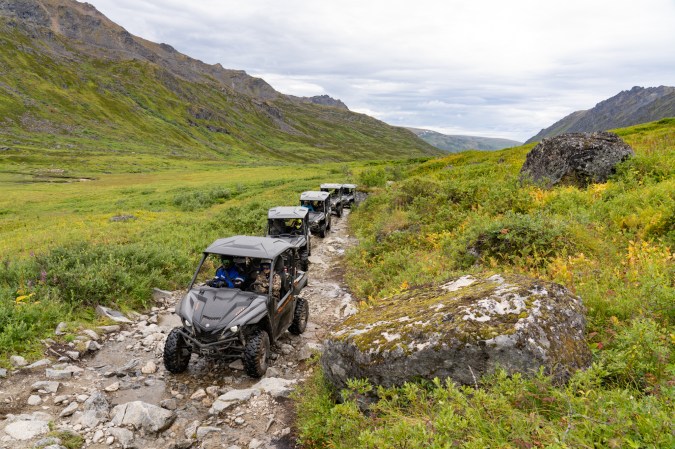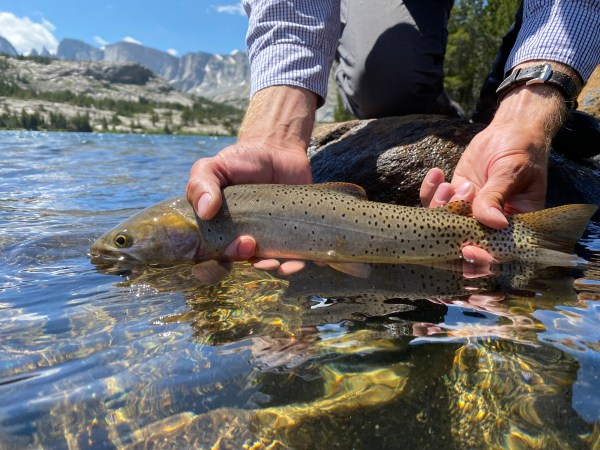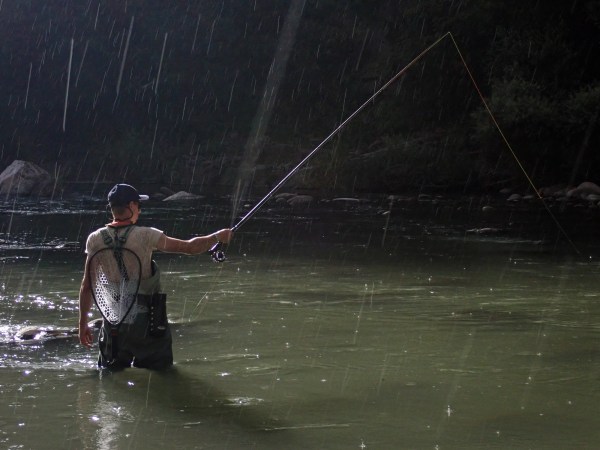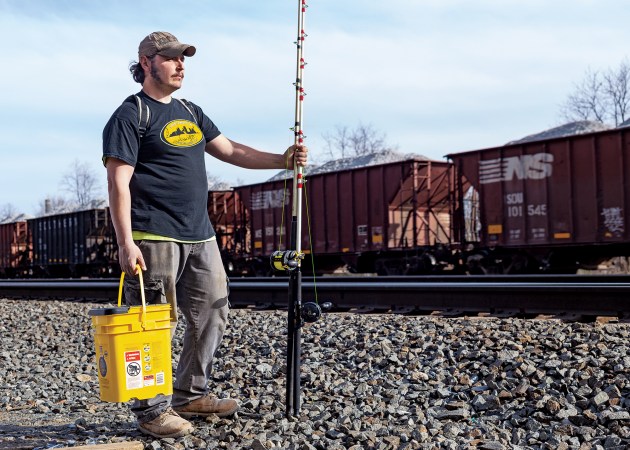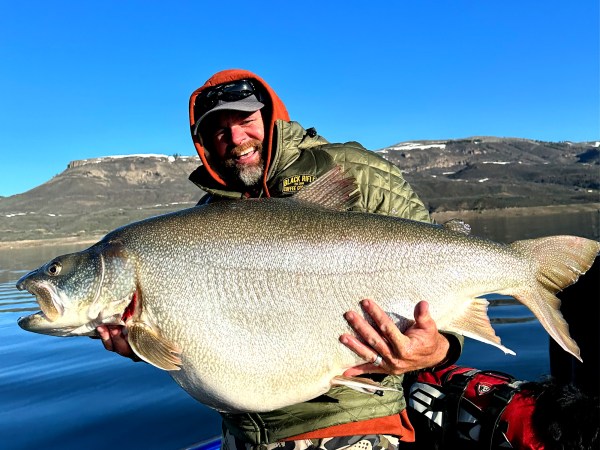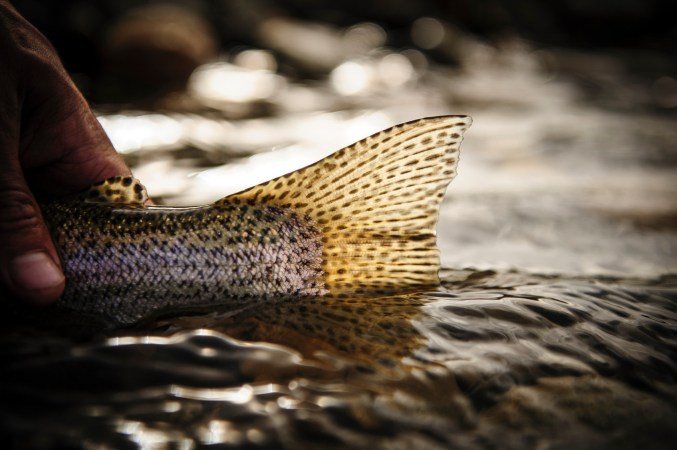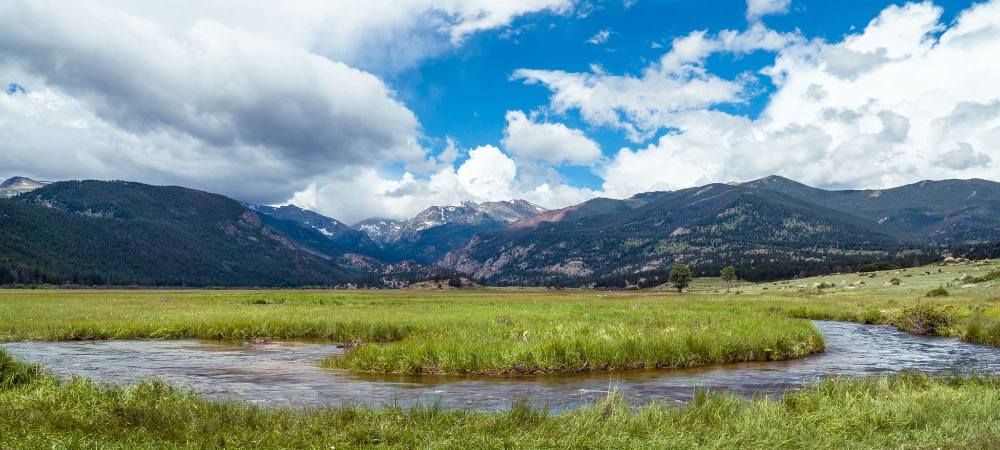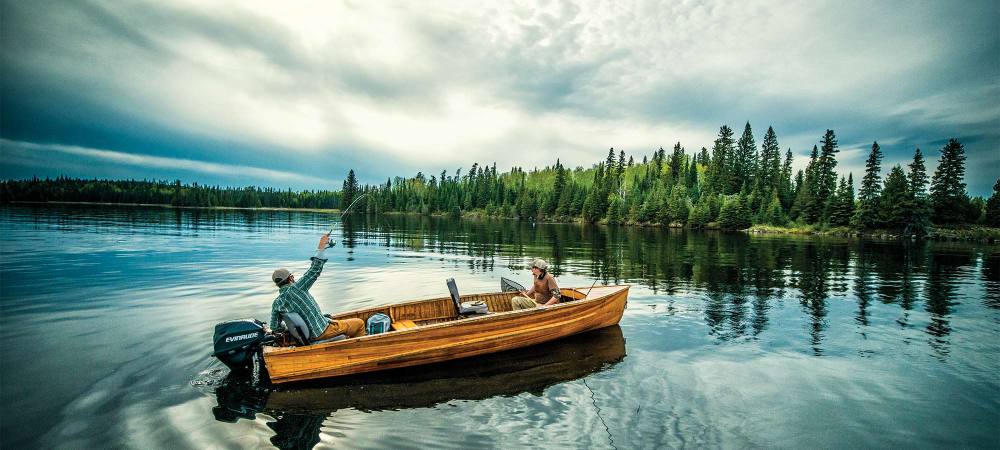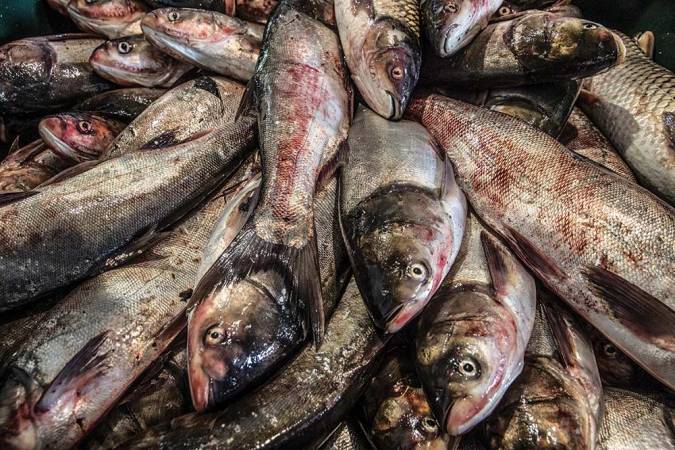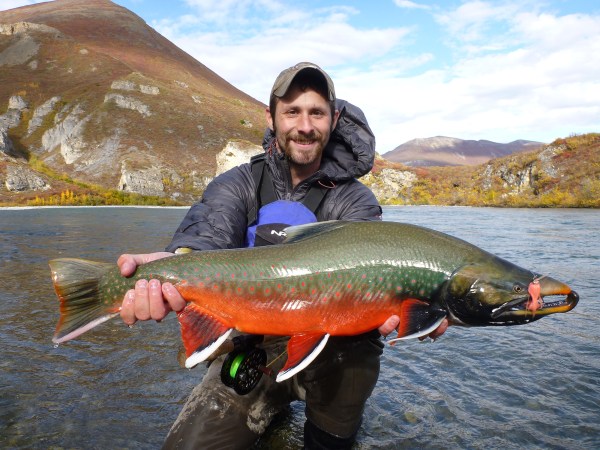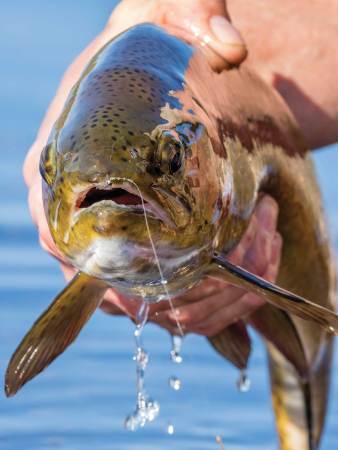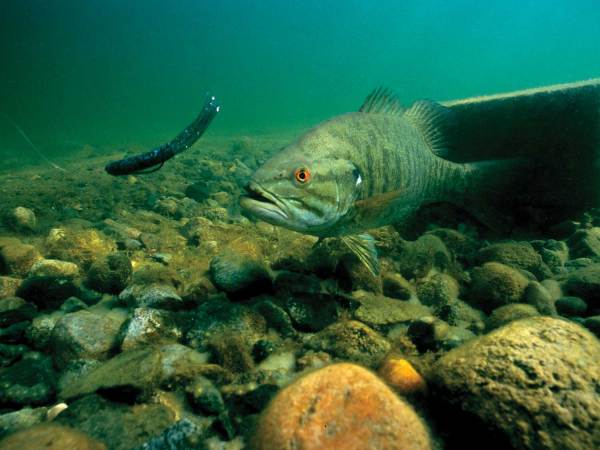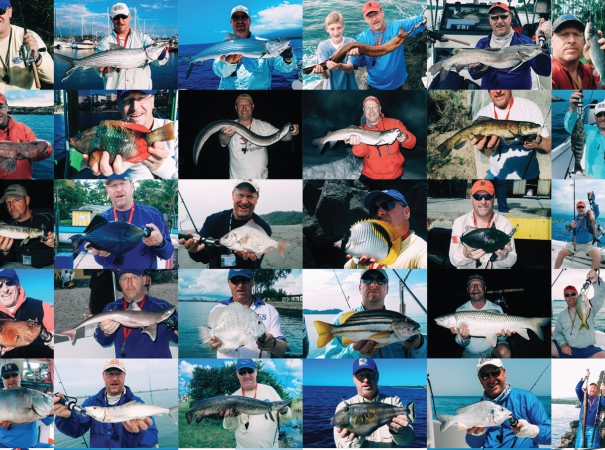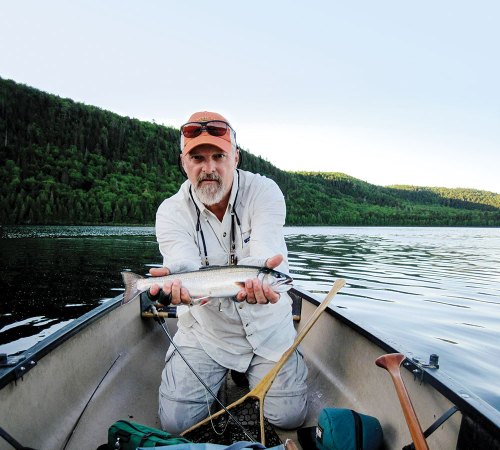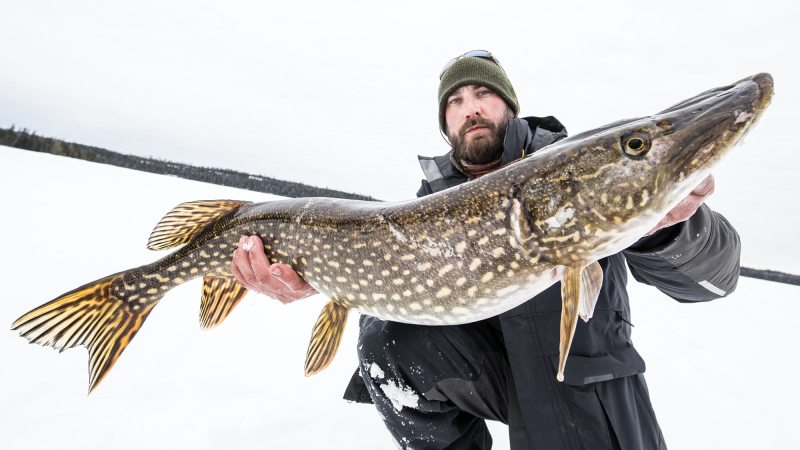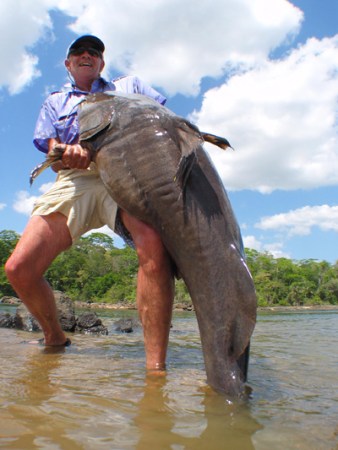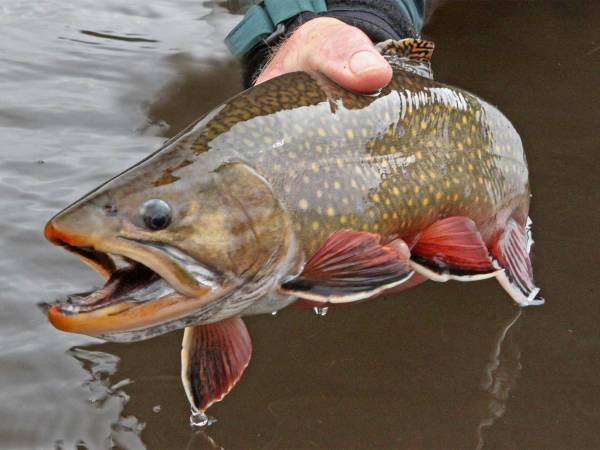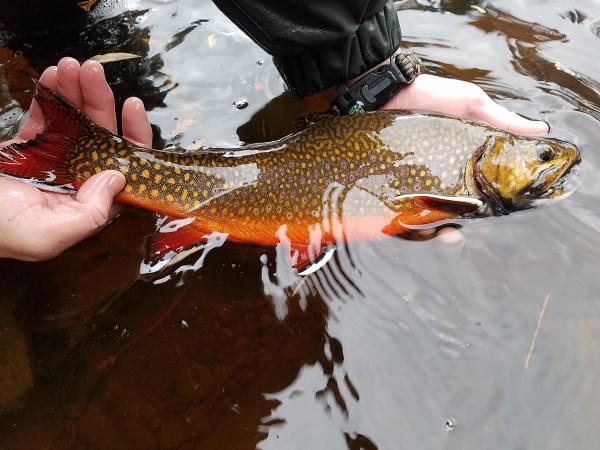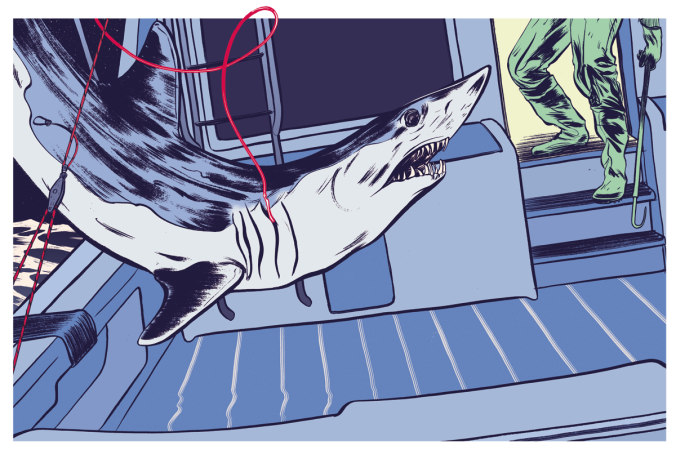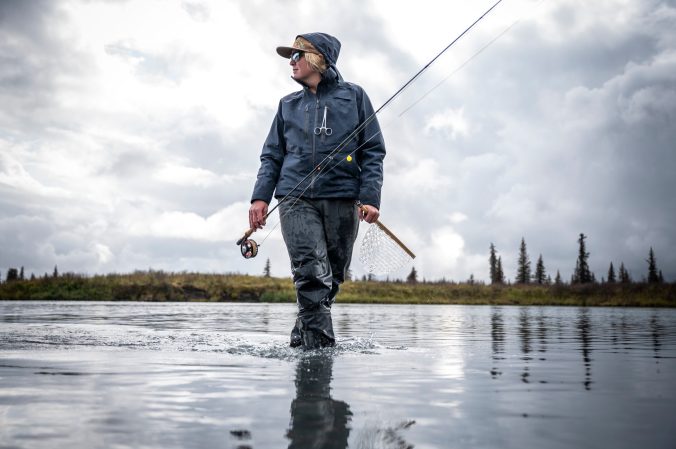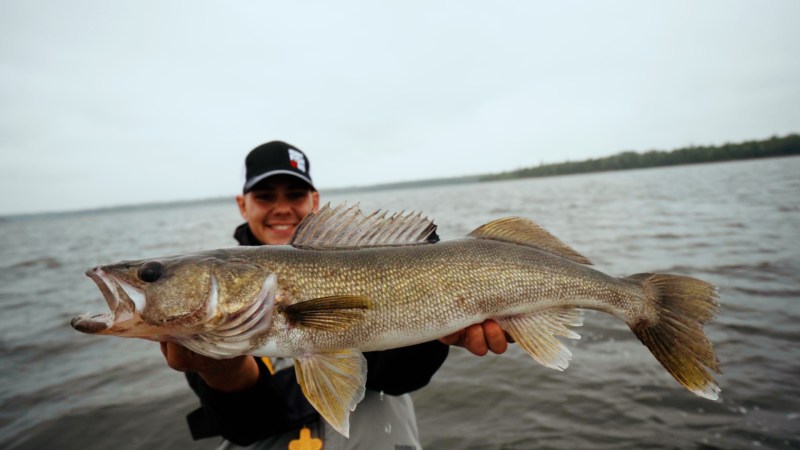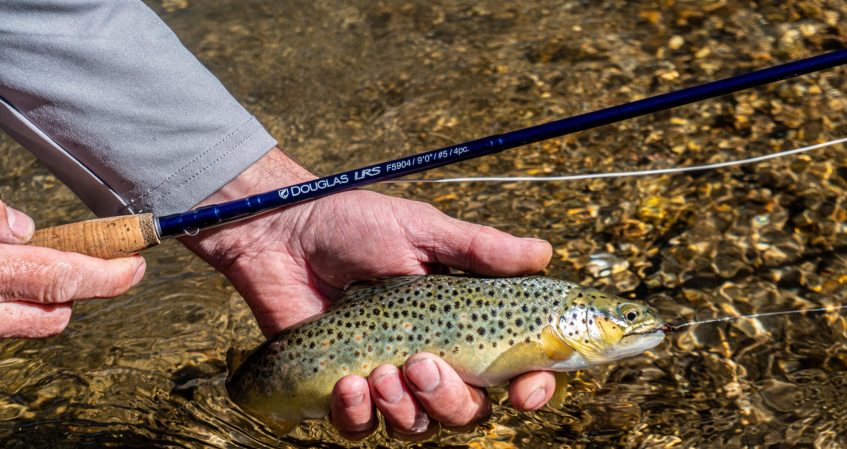When we came off the trail onto the overlook at the falls, the two kids stood open-mouthed and wide-eyed, their heads swiveling as they said to Steve and me things like: “Dad, look! Look! Wow. Dad!” A dozen brown bears patrolled the river, some only yards from the elevated platform we were standing on. The “smaller,” younger bears roamed the banks, picking over half-eaten salmon. The river seethed as dense pods of red salmon surged upstream. Huge mature bears staked out the prime fishing spots, some catching salmon as they leapt the cataracts. Others charged into the water, coming up with salmon flopping in their jaws while the river around them exploded in a spray of panicked fish. We were at Brooks Camp, the world-famous bear-viewing spot in Alaska’s Katmai National Park. My son, Oliver, age 9, and I were there with my buddy Steve McGrath and his 11-year-old son, Aidan, taking time out from our weeklong fishing trip for what Steve and I recognized as a bucket-list experience.
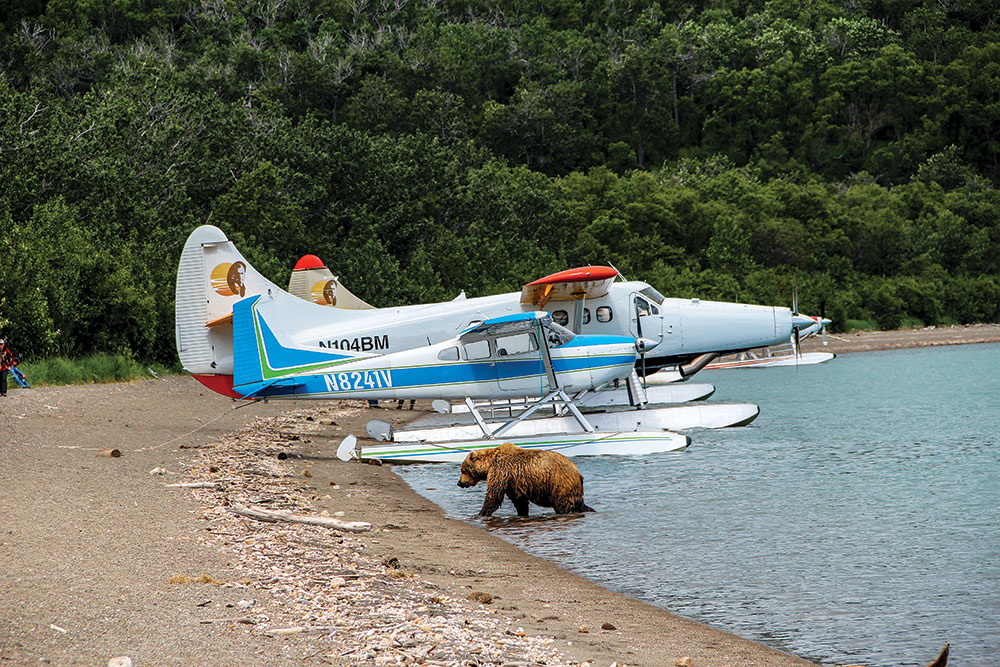
Steve and I have traveled enough in Alaska and elsewhere that we’ve both been around our fair share of bears. But we’d never seen anything like this.
A constant stream of salmon launched themselves several feet in the air trying to clear the falls—there were at least 10 in midair at any given time—and more bears than I’d seen in my life were there to catch them. We watched one massive boar take up a position at the base of the falls where one salmon after another slithered across a rock in a few inches water. He’d slam down a paw, chomp on the fish, eat the head, tear away some guts and skin, then let what was left of the flayed sockeye drift down the current for the birds and young bears to fight over. We stopped counting after he caught 36.
Maybe that’s what made the boys so hungry. After two hours of a front-row seat to the most awesome nature show, Aidan and Oliver started to fade. They got grumpy. They wanted lunch and were ready to go.
Snacks. If there is one thing I’ve learned while trying to raise my son as an outdoorsman, it’s that nothing will hold a kid’s attention if there are no snacks. Carrying food is strictly forbidden in Brooks Camp—sound policy when you’re in close quarters with brown bears on a feeding frenzy. I could’ve stayed all day, and I tried to make the boys understand that they would most likely never see this again, but kids don’t think like that.
Steve, the brains behind our adventure, gracefully reminded me what this trip was all about.
“All right, let’s get out of here without running into a bear on the trail and get some food into you two cubs,” he said with a smile. “Then we’ll drop in on a lake on the flight back to the lodge because we have a lot more fish to catch.”
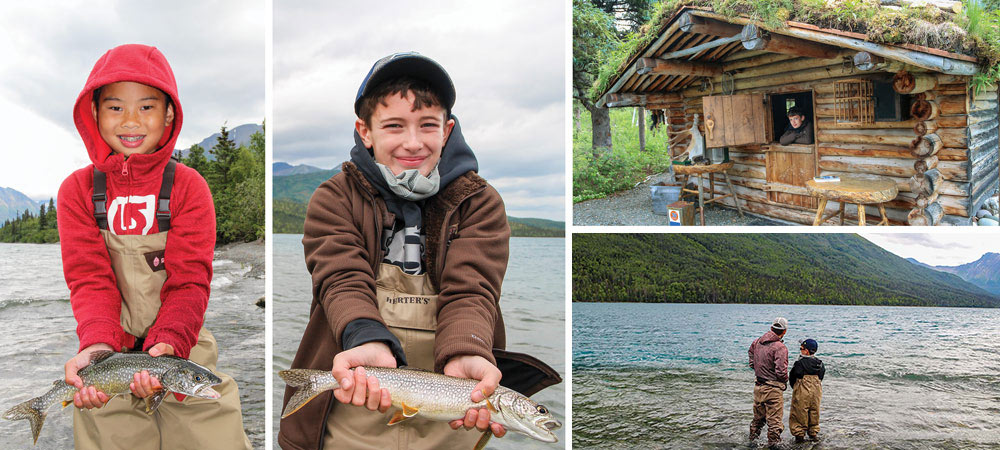
Grayling, Lakers, Char, Pike, Salmon, and Rainbows
When you’re trying to get a kid to love the outdoors, is there such a thing as too much, too soon? Steve and I were going to find out.
The two of us love to hunt, fish, hike, and camp so much that we’ve each built careers around the outdoors. We’ve been lucky to share camps in some of the best places to hunt and fish in North America, but for the past few years, we’ve each been focused on something both more rewarding and more challenging: passing our love for the outdoors on to our children. These days, instead of swapping stories about our hunting and fishing adventures, Steve and I end up mostly talking about catching panfish with our sons or sharing stories of little, unremarkable hikes close to home. Realizing how desperately we want to share this lifestyle with our kids, and struggling with how to mentor a young outdoorsman in a life packed with work, school, sports, friends, and all kinds of modern distractions that we never faced, we hatched a plan. We’d take the boys to Alaska on the kind of trip of a lifetime that we could only dream about when we were their age. Would they realize how lucky they were? Did that even matter?
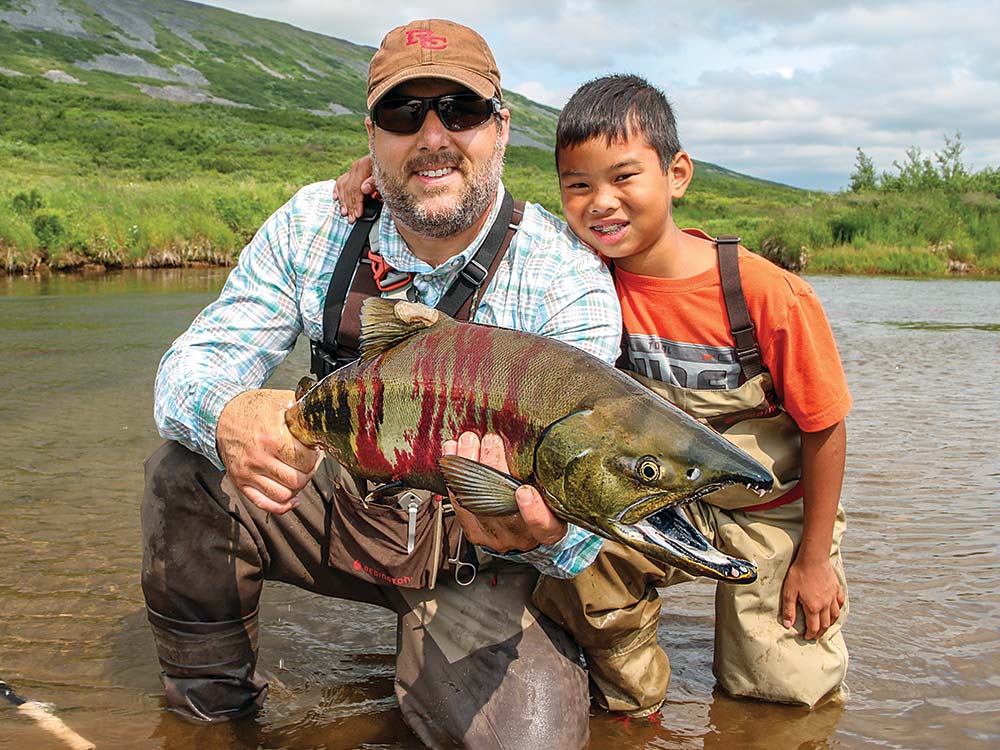
And so, after a day of indoor mini golf and chicken wings in Anchorage while the boys became fast friends in the pure and near-instant way that only kids can, we landed in Port Alsworth, smack in the middle of Lake Clark National Park in south-central Alaska.
We’d be staying in a cabin at the Farm Lodge, and our guide would be Glen Alsworth, the third generation in a clan of legendary bush pilots. His grandfather Babe had homesteaded the spot in the 1940s, developing the airstrip and playing a prominent role in the history of the area. Glen’s father runs Lake Clark Air, the regional air service based out of Port Alsworth, and Glen and his children run the lodge. It is a family affair, and it’s one reason why the Farm Lodge makes for a perfect family vacation spot. The other reason is the incredible fishing in Lake Clark National Park.
We’d spend the week using bush planes to reach remote spots where the fish rarely, if ever, have seen a lure or fly. We would hike from the lodge up the wilderness rivers, catching grayling in the riffles and pools. We’d camp on remote shorelines, casting to cruising lake trout and char. We’d take a boat to shallow bays on Lake Clark, sight-fishing to huge pike lurking in the weeds. And we’d land on the tundra, catching salmon, grayling, and rainbow trout in a river where the only other anglers are brown bears. We dads thought it sounded like an awesome plan.
A half-hour after landing at the lodge, we were back in the air, this time in a Cessna floatplane loaded with rods (and plenty of snacks), headed to a cove where a stream poured into the lake. It was a perfect spot to warm up with our first fish.
Steve and I got the boys set up with spinning rods and Vibrax spinners, and within 10 minutes, Aidan hooked and landed a beautiful lake trout. Oliver followed with a fat Arctic char and then a grayling, its saillike dorsal fin standing high over its spotted back.
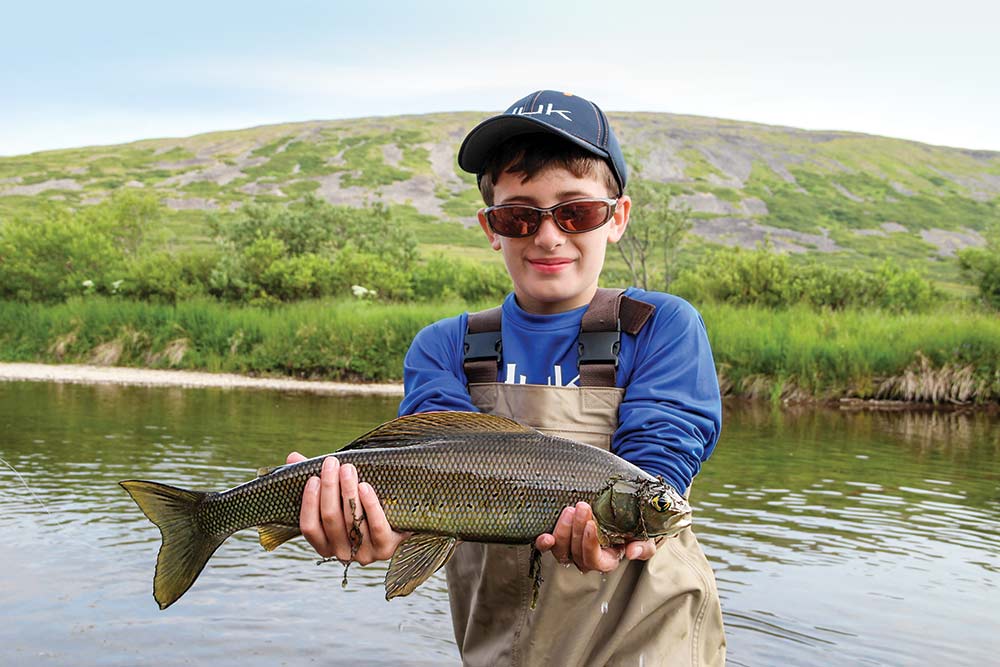
“Dad, do we have these in New Jersey?” he asked. No buddy, we don’t.
Both boys smiled and laughed, marveling at the hard, bright fish in their hands and posing for the obligatory pictures. They each caught and released several fish over the course of an hour. Then they set down their rods and started horsing around along the shoreline, turning over rocks, throwing sticks, and putting their new waders to use by braving the water as deep as they dared. I had a feeling we’d have to leave this spot once one of those two jokers pushed his luck and soaked his clothes, and by the looks of things, it might be soon.
Steve smiled, shrugged, and said, “The boys are having fun,” as he tied an egg-sucking leech on his leader. He bombed out a fly cast into the wind, and quickly hooked a lake trout of his own. I rigged my 5-weight and started catching a mixed bag of trout, char, and grayling.
We had told ourselves that this trip was all about the kids, but part of mentoring a young angler is showing him or her how it’s done, isn’t it? As we cast and caught and hooted and hollered, Steve and I were teaching them that a wilderness lake full of aggressive fish is among the most wonderful places in the world.
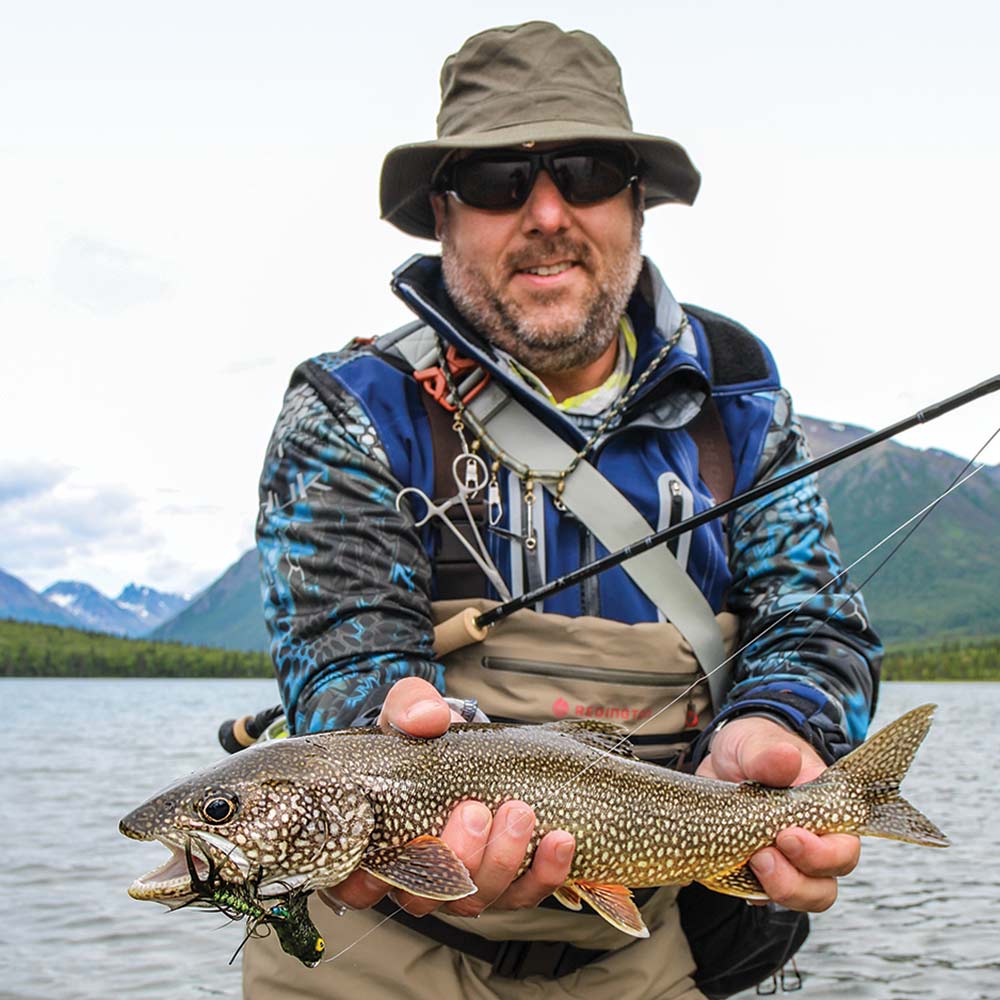
A Man Among Boys
I figured an added bonus of this trip would be impressing our boys with our outdoors skills. Here in the wilderness, I’d get to show off a kind of quiet but confident backwoods competence, and Oliver would be proud of his old man. But as we set up camp on a remote stretch of the Lake Clark shoreline, I realized I was hopelessly outclassed. Caleb Alsworth, Glen’s 14-year-old son, was helping the boys start a fire, and they looked at him with pure awe. When Steve and I had tried to get the boys to pitch in and help out, they sulked, but they jumped to impress Caleb, gathering wood, running for the matches.
Only a few years younger than Caleb, Oliver and Aidan could look at him and see a peer but also something much more impressive. He wore a revolver chambered in .44 Magnum slung across his chest, providing us with protection from the bears that are always a concern in the Alaskan bush. Back at the lodge, they had watched him practicing his “touch-and-goes” on the airstrip, a fourth-generation bush pilot in training. And here, at our wilderness camp, Caleb was clearly in charge.
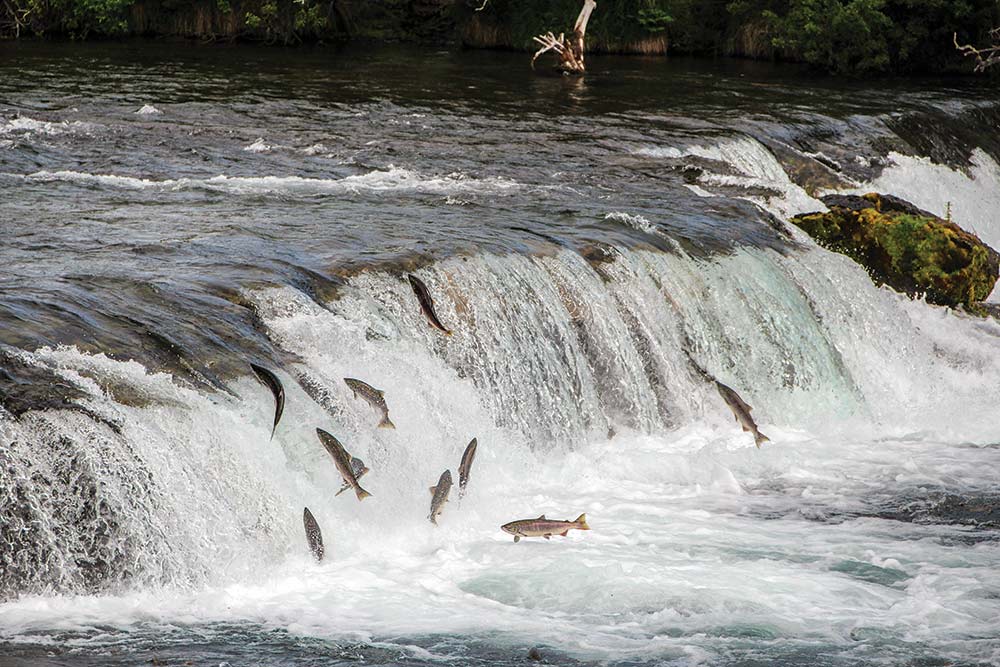
“Dude,” Steve whispered to me as Caleb led the boys on a hike up the shoreline, “Caleb is twice the man that you or I are.”
I had no argument there. He was also a great kid—unfailingly polite, funny, and focused on making sure Oliver and Aidan were having a blast.
With the two of them busy hanging out with Caleb, Steve and I waded out into the lake. We were camped at a narrow neck in the shoreline, where the lake trout cruised along a channel within reach of a long fly cast.
One of the great things about summertime in Alaska is how much more time you get because of the long days. It was almost like being able to fit two weeks’ worth of activities into one week. And now, at 9 p.m., camp was all squared away. The boys had caught their fill of fish. We had eaten hot dogs and sausages roasted over the fire. We still had at least three hours of daylight left, so Steve and I rigged up our fly rods with big articulated streamers.
In most places, most of the time, lake trout are a deepwater fish, so the opportunity to catch them shallow on a fly was an opportunity we were going to make the most of.
I looked up at the peak looming on the other side of the lake, spotted a black bear working through an open slide, and made my first cast. Three strips into the retrieve, the fly stopped with a jolt. I struck hard, came tight, and then held on as the fish tore line from the reel. When I brought the fish to hand, it was a chunky laker with a fat belly and bright markings.
Over the next few hours, Steve and I each caught several, almost all of them clones of that first fish. We each landed more lake trout than we’d caught on a fly in our whole lives. It was still light when we cried uncle and climbed into our sleeping bags, the boys already out cold.
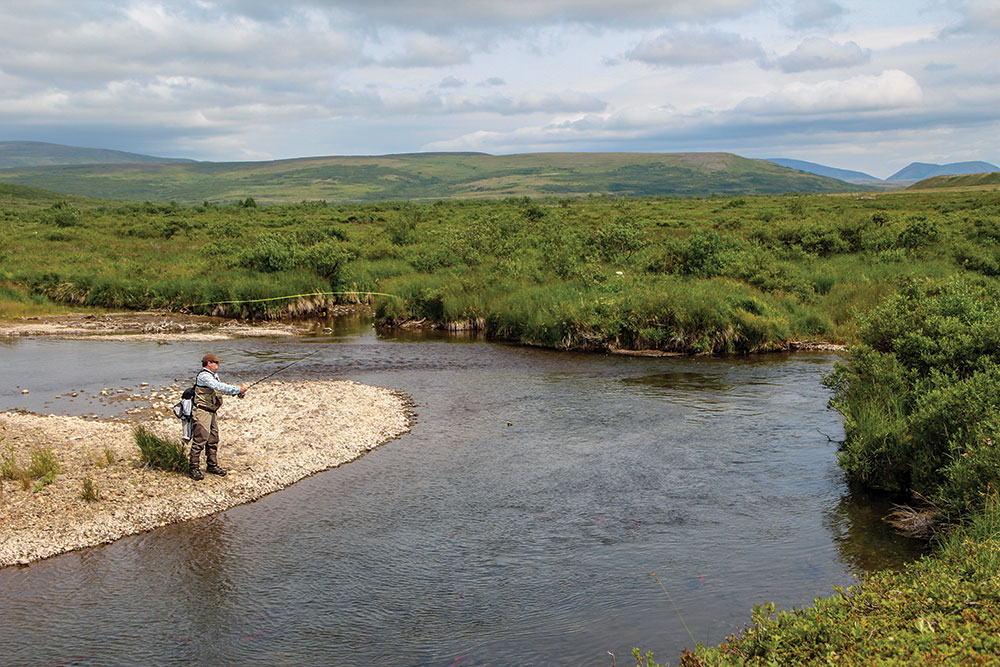
How to Raise a Fly Snob
Before the trip, Oliver had been begging me to teach him how to flyfish. He was already pretty skilled with a spinning rod, and I figured Alaska was about the best place to put a fly rod in his hands. I had big plans for casting lessons in the yard and trips to the local pond to catch bluegills on flies before the trip, but I blew it. I was busy with work, he had school and other activities—all the usual excuses that Steve and I came here to get away from.
Two days in, after he had caught a lot of fish on spinning tackle, Oliver was asking me to let him use his fly rods. I hesitated. Things were going so well, and I didn’t want him to get frustrated and discouraged with the flailing and tangles and difficulty of learning to flyfish. But wasn’t expanding his fishing horizons the point of this trip? Was I worried about him getting frustrated, or did I not want to waste any of my time dealing with the hassle of teaching someone to flyfish?
I grabbed the fly rods and took him down to the docks at the lodge for a quick casting lesson before we started out for the day’s fishing, a hike up the river to a waterfall where grayling hung stacked in the current. After about 20 minutes, he was making decent casts.
The hike there was gorgeous, climbing steep timbered bluffs along the river, but it was also one of the times when we pushed the boys with results that at first weren’t gratifying. At various times along the 5-mile hike, each one of them complained and sulked and seemed miserable. When Steve and I planned the trip, we’d imagined that having a buddy along for our sons would ensure they had a partner to share in the fun with. That certainly proved true, but it worked the other way as well. When one of them dragged, he brought the other down with him.
But once we reached the falls, everything changed. The river poured over the cliff face in a spectacular wall of sound and spray, and when we began fishing in the pools and riffles below, the boys started catching grayling one after another.
Oliver started with a nymph and quickly caught his first fly-rod fish. He switched to a dry and caught another, then another. Grayling are perfect for a new fly angler. They’re not picky, and they aggressively attack nymphs, streamers, and dries. Watching them come up and slam his fly hooked Oliver. He wouldn’t touch his spinning tackle the rest of the trip. I want to raise a fisherman, not a fly snob, but he loved the fly rod so much, and used it so well, that I couldn’t help but be thrilled.
That night over supper, we didn’t hear any complaints. They boys talked about the falls and the fish, and bragged about how far they hiked. They also ate like grizzly bears and then passed out, dead tired.
Read Next: Apprentice & Mentor
Top Predators
In general, the toothier, meaner, and more aggressive a fish is, the more kids like catching it. I guess some adults feel the same way.
On the second to last day of the trip, we took a boat to a shallow cove on Lake Clark that was full of pike. We let the boys start—this trip was about them, right? And each quickly caught a big pike. The fish slashed at their lures and flies, blowing up on the surface. When these mean-looking predators came in, the boys were a little afraid to handle them—with good reason.
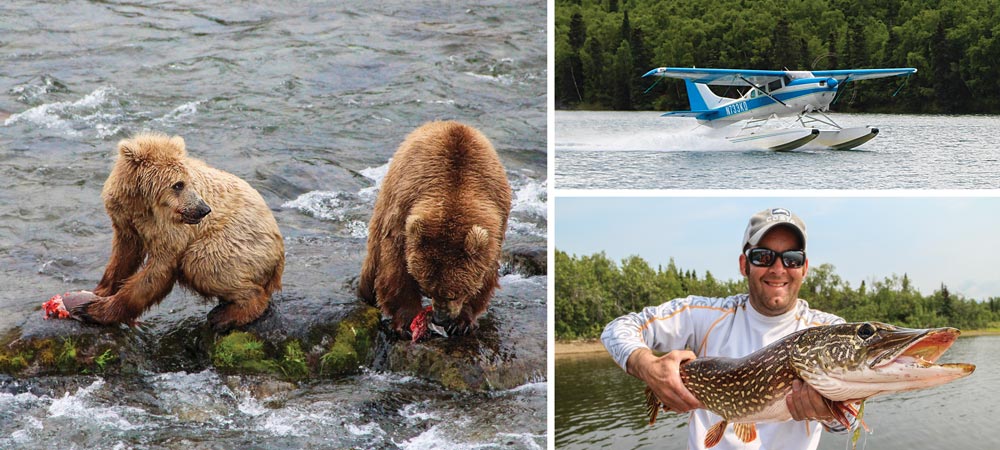
After watching the boys catch a bunch of pike from the shore, we piled into the boat and silently drifted through the shallows, spotting fish from the bow. We took turns casting lures and big streamers at pike we saw lurking in the weeds, hearts thumping as we watched the mugging take place. I’d see a big one following my big rabbit-fur streamer, stripping faster and faster until it pounced in a last-minute rush of aggression. It was one of those days of fishing when I forgot to eat, but so did the boys. We talked only to point out targets. We were all shocked when we realized we’d been doing it for hours and that the day was over. We sat smiling and stunned, on a total fishing high.
The last day was one we’d been looking forward to all week. We flew early in the morning in two small, light planes: Stinsons equipped with tundra tires and able to take off and land in small spots. The destination was a tundra river that should hold lots of salmon at that time of year. From the air we saw a big brown bear fishing a couple hundred yards from the landing spot, and when we first looked down into the clear river from the bluff, we could see why. The water pulsed with dense pods of red and chum salmon, moving like a mob through the pools and charging through the shallows, their dorsal fins waving in the air. The river was also full of big rainbows feeding on eggs, and, of course, the ever-present grayling. The banks were covered in bear tracks, piles of scat, and half-eaten salmon. The boys would need to stick close to Caleb and his .44 Magnum.
Oliver, at this point a committed fly snob, caught grayling after grayling on dries and egg-sucking leech patterns. It took only about an hour for a big sockeye to slash at his leech out of anger. Oliver’s excitement turned to something like fear when he realized that he was battling a beast of a different magnitude. Aidan hooked one around the same time. Steve and I offered some tips and encouragement, but we didn’t take the rods. After everything we had done that week, we knew the boys could handle it.
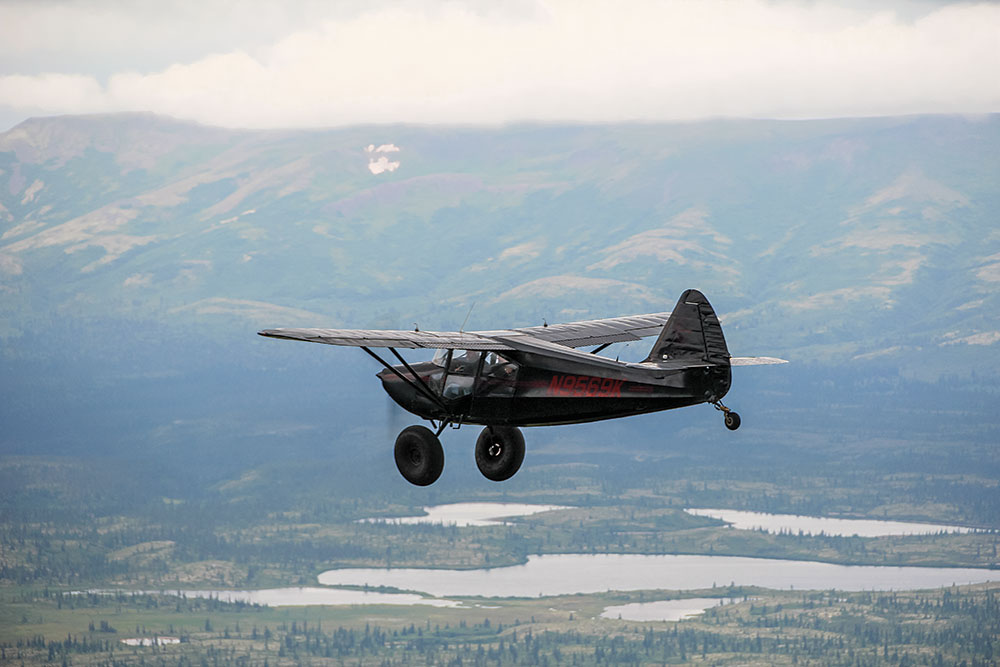
After they landed those fish, you could almost see the boys grow. See them swell and puff up. The fish were so big that they strugged to hold them for photos, but they caught them. On their own. Even Caleb was impressed.
It was another gloriously long Alaskan day. The planes wouldn’t be back to get us until nine. We’d eat some simple but delicious grub cooked over the fire. After the boys had caught their fill of salmon and grayling, Steve and I left them in Caleb’s capable hands. We saw them playing on the burned fuselage of a wrecked plane (“There’s one that didn’t stick the landing,” Glen wryly noted earlier as we taxied past). For a couple of hours, they wrestled on the tundra like a couple of bear cubs. Meanwhile, Steve and I explored the river, sight-fishing to rainbows and hooking reds and chums. None of us wanted it to end.
Steve and I had almost impossible expectations for this trip. Will it turn each boy into a lifelong outdoorsman who wants to spend time with his father in the field? Time will tell, but the initial results look promising.
Before we boarded our respective flights home, the four of us sat in an airport restaurant rehashing the trip. The boys talked about the fish, of course, but also the bears. They talked about the juvenile boar we ran into on the trail at Brooks Camp, but not about being hungry and ready to go. The hike to the falls was now an epic adventure, and the hardship only served to show how tough they were. They started asking us where we were all going on our next trip. They certainly sounded like outdoorsmen.
Next to us sat a man and his adult son, about 15 years ahead of where Steve and I were with our kids. They overheard us talking, and we started swapping stories. They were just back from a 10-day wilderness float.
When they got up to leave, the father leaned close to me and Steve and said: “You boys just keep doing what you’re doing. You’re doing it right, and let me tell you, it’s all worth it.” It was the high point of my trip.
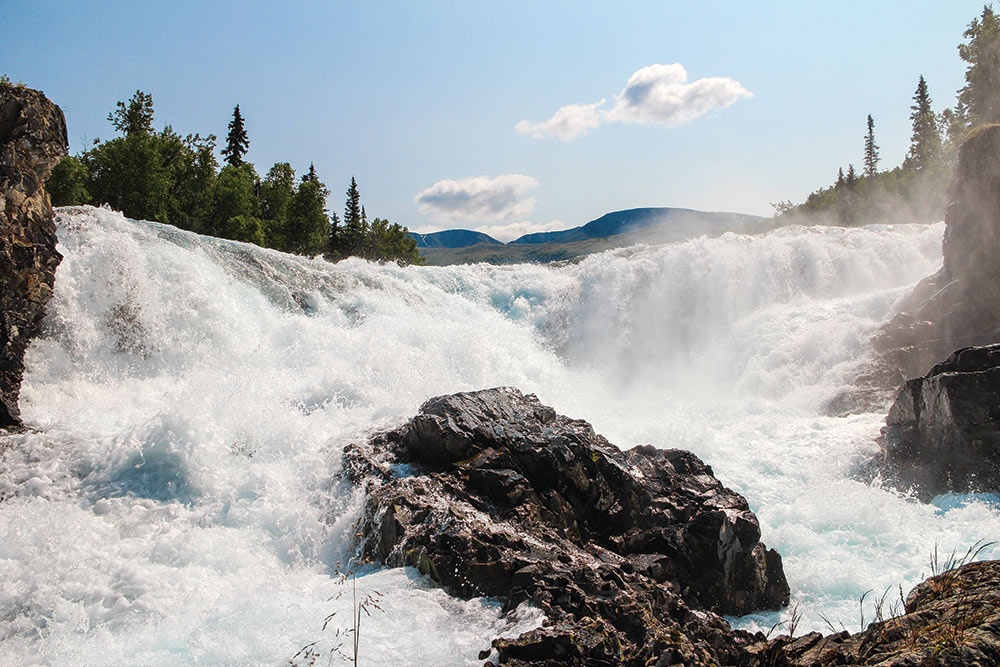
If You Go…
Lodge
Located in Port Alsworth in Lake Clark National Park and Preserve, the Farm Lodge is a family-run outfit that caters to families looking to mix fishing with wildlife viewing and sightseeing. The cabins and lodge are new and very comfortable. The food is great, and the staff is welcoming and friendly. Best of all, the pilots are some of the most experienced in Alaska.
Waders
Good waders are key. The boys used Redington Crosswater youth waders and Prowler boots.
Tackle
For spinning gear, we brought Fenwick HMG travel rods and an assortment of Blue Fox Vibrax spinners. For fly rods, we used a Sage X 7-weight and Redington Predator 8-weight for salmon and pike, and Thomas & Thomas Aeros 5-weights for grayling, trout, and char. We kept them unharmed through many air miles in a Simms Bounty Hunter Rod Vault.
Clothes
The weather was perfect on our trip, but this is Alaska, so good raingear is key. We wore Cabela’s Guidewear and Huk Kryptek. The rest of our clothing was by [Browning](www.browninglifestyle.com), a mix of flannels and fleeces that we could layer and that did double duty on the water and in the lodge.
